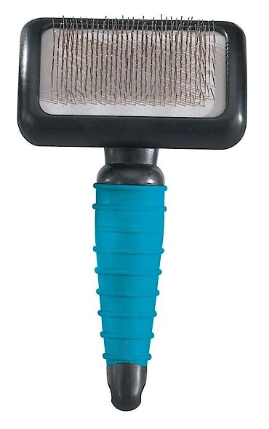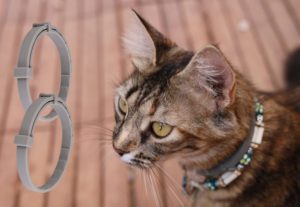You might think that brushing your cat is easy, but did you know that the right cat brush can make a big difference for your furry friend’s grooming needs? Cats are very good at cleaning themselves, but they still need some assistance from their caring owners. Brushing them regularly not only helps their coat stay smooth and glossy but also supports healthy skin and lowers shedding. In this detailed guide, we’ll explore the world of cat brushes, looking at the different kinds available and helping you choose wisely.
Exploring Different Types of Cat Brushes
Different cats have different needs when it comes to grooming, and not every brush works well for every cat. Here are some of the most common kinds of cat brushes and what they are good for:
Slicker Brush: The Versatile Essential

A slicker brush is a must-have in every cat owner’s grooming toolkit. With its fine, bent bristles arranged in rows on a flat or curved surface, this versatile brush is designed to remove loose hair, mats, and tangles from your cat’s coat. It works wonders on medium to long-haired cats or those with thick or curly fur. Even short-haired cats can benefit from a slicker brush, but remember to be gentle to avoid irritating their sensitive skin.
To use a slicker brush effectively, start from the head and gently brush in the direction of hair growth, working your way down to the tail. Avoid brushing against the grain or applying too much pressure. If you encounter a mat or tangle, try to loosen it with your fingers before using the brush. Don’t forget to clean the brush regularly by removing the accumulated hair.
Some of the pros of a cat slicker brush are:
| Pros | Cons |
|---|---|
| Removes tangles, mats, and loose hair | Can be too harsh for some cats |
| Works well for both long-haired and short-haired cats | Requires more frequent brushing |
| Easy to clean with self-cleaning feature | Can be more expensive |
Bristle Brush: Adding Polish and Shine

If your cat has short to medium hair or a smooth and silky coat, a bristle brush is an excellent choice. This brush features soft or stiff natural or synthetic bristles evenly spaced on a flat or curved surface. Not only does it remove dirt and debris, but it also helps distribute natural oils, giving your cat’s fur a polished and shiny appearance.
When using a bristle brush, follow the direction of hair growth, starting from the head and moving towards the tail. You can also incorporate circular motions to massage your cat’s skin and improve blood circulation. Regular cleaning of the brush ensures optimal results by removing dirt and debris from the bristles.
The pros and cons of a bristle brush:
| Pros | Cons |
|---|---|
| Removes loose hair and prevents hairballs | Ineffective for removing mats and tangles |
| Works well for short-haired or smooth-haired cats | Requires more pressure and strokes |
| Gentle and comfortable for sensitive skin | Harder to clean |
Comb: Untangling the Knots

When it comes to tackling mats, tangles, and giving the fur a fluffed-up look, a comb is the go-to tool. Combs come with teeth that can be spaced close together or far apart, and they are suitable for cats with any hair length or type. However, different sizes or styles of combs may be necessary based on your cat’s specific coat. For example, a wide-toothed comb works well for coarse or curly hair, while a fine-toothed comb is ideal for smooth or silky hair. If your cat has fleas or eggs, a flea comb can help get rid of them.
To effectively use a comb, start from the head and gently comb in the direction of hair growth, moving towards the tail. Take care not to comb against the grain or pull too hard on the fur. If you encounter a mat or tangle, try to loosen it with your fingers before using the comb. Using a detangling spray or conditioner can also help ease the removal process. Don’t forget to clean the comb by removing the hair from the teeth regularly.
The pros and cons of a cat comb:
| Pros | Cons |
|---|---|
| Effectively removes mats and tangles | Can be too harsh or painful |
| Works well for both overcoat and undercoat grooming | Requires more skill and patience |
| Gentle and comfortable for sensitive skin | Harder to clean |
Shedding Tool: Minimizing the Mess
If your cat is a shedding machine, a shedding tool can be a game-changer. These tools usually consist of metal blades or teeth attached to a handle and are designed to remove loose undercoat hair, minimize shedding, and prevent hairballs. They are particularly effective for cats with medium to long hair or those with thick or double coats. However, be cautious when using shedding tools on short-haired cats to avoid damaging the topcoat or irritating the skin.
To make the most of a shedding tool, stroke your cat’s fur gently in the direction of hair growth, starting from the head and moving towards the tail. Avoid stroking against the grain or applying excessive pressure. Opt for short and quick strokes, rather than long and slow ones, to remove more hair. Cleaning the tool regularly by removing the accumulated hair ensures its effectiveness.
The pros and cons of a cat shedding tool:
| Pros | Cons |
|---|---|
| Effectively reduces shedding | Can be too harsh or painful |
| Improves skin and coat health | Can be expensive |
| Easy to use and clean | Can require more caution and care |
Rubber Brush: A Soothing Massage
For a multi-purpose tool that removes loose hair, dirt, and debris while providing a soothing massage for your cat’s skin, a rubber brush is a fantastic option. Rubber brushes are ideal for cats with short to medium hair or those with smooth and silky coats. While they can be used on long-haired cats, they may not be as effective in removing mats and tangles.
To use a rubber brush, gently brush your cat’s fur in the direction of hair growth, starting from the head and moving towards the tail. Circular motions can also be incorporated to give your cat a relaxing massage. Regularly cleaning the brush by removing accumulated hair, dirt, and debris ensures optimal performance.
The pros and cons of a cat rubber brush:
| Pros | Cons |
|---|---|
| Gently removes loose hair and prevents hairballs | Ineffective for removing mats and tangles |
| Works well for short-haired or smooth-haired cats | Requires more pressure and strokes |
| Comfortable and soothing for sensitive skin | Harder to clean |
| Benefits of Brushing Your Cat |
|---|
| Brushing your cat regularly can have many benefits for both you and your cat. Here are some of them: Reduced shedding and hairballs: By removing loose hair from your cat’s coat, you can prevent it from ending up on your furniture, clothes, or floor. You can also reduce the amount of hair that your cat ingests while grooming themselves, which can cause hairballs in their stomach or intestines. Improved skin and coat health: By brushing your cat, you can stimulate their skin and blood circulation, which can improve their skin condition and prevent dryness, flakiness, or irritation. You can also distribute natural oils throughout their coat, which can protect it from dirt, bacteria, and parasites. Prevented mats and tangles: By brushing your cat, you can prevent their fur from forming mats or tangles, which can be painful, uncomfortable, or even harmful for your cat. Mats or tangles can pull on your cat’s skin, cause infections, or hide wounds or parasites. Strengthened bond: By brushing your cat, you can show them your love and care, which can strengthen the bond between you and your cat. Brushing your cat can also be a relaxing and enjoyable activity for both of you, as it can release endorphins and reduce stress. |
| To learn more about effective cat grooming techniques, please read our article: Essential Cat Grooming Techniques for a Healthy and Happy Cat |
Choosing the Right Brush for Your Cat
We have seen the various kinds of cat brushes on the market, but how do you find the best one for your fluffy friend? These are some important aspects to think about:
Consideration of Coat Type
Your cat’s coat type plays a significant role in determining the right brush. Short-haired cats, with their single layer of hair less than 1.5 inches long, can benefit from a bristle brush or a rubber brush. Medium-haired cats, with hair between 1.5 and 3 inches long, often require a slicker brush or a comb to handle mats and tangles.
Long-haired cats, with their dense and fluffy coats longer than 3 inches, need more attention and typically require a slicker brush, a comb, and even a shedding tool. Tailoring your brush choice to your cat’s specific coat type ensures the best grooming results.
Personal Preference
When selecting a cat brush, your personal preferences matter too. Consider factors such as design, handle, size, shape, and material. An ergonomic handle that fits comfortably in your hand might be a priority, or you may prefer brushes with soft or hard bristles, depending on your desired level of gentleness or firmness on your cat’s fur.
Equally important is considering your cat’s preference. Cats have unique personalities, and their reactions to grooming tools can vary. Some may enjoy the sensation of a rubber brush massaging their skin, while others may prefer a slicker brush for detangling their fur. Experiment with different brushes and observe your cat’s reactions.
Pay attention to their body language and vocalizations. If your cat purrs, kneads, rubs against you, or relaxes during brushing, they are likely enjoying the session. On the other hand, if your cat hisses, growls, bites, scratches, or tries to escape, they are signaling their discomfort. By observing your cat’s preferences, you can find the brush that suits them best, creating a positive and enjoyable grooming experience.
Cat’s Behavior
Your cat’s behavior also plays a role in determining the ease and frequency of grooming sessions. Cooperative cats are easy to groom and willingly allow you to brush them. They sit still and are cooperative throughout the process. These cats require minimal training and encouragement.
On the other hand, some cats resist grooming and dislike being brushed by their owners. They may struggle, squirm, or fight back. Grooming-resistant cats necessitate additional training and encouragement.
If your cat is cooperative, you can choose any brush that suits their coat type and your preference. You can also groom them as often as necessary, based on their shedding or dirt accumulation.
For resistant cats, opt for a brush that is gentle on their skin and fur, such as a rubber brush or a soft-bristled brush. These brushes are less likely to cause discomfort and can gradually help your cat become more accepting of grooming sessions.
Conclusion
To keep your cat’s fur healthy and shiny, regular brushing is essential. The right brush can make a big difference in how well you can groom your cat. You should think about your cat’s coat type, likes and dislikes, and behavior when choosing a brush. This way, you can find the best brush that suits your cat’s grooming needs and makes grooming a pleasant experience for both of you.
With a passion for cats and years of experience in cat care and grooming, I have gained valuable insights and expertise that I want to share with other cat lovers. I believe that every cat deserves the best care possible, and through this platform, I aim to empower cat owners like you to provide the utmost love and care for your feline companions.
No related posts.



